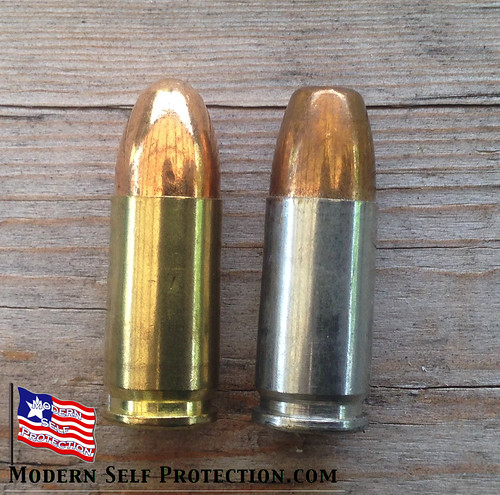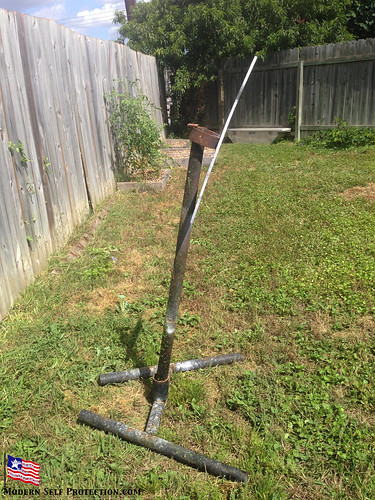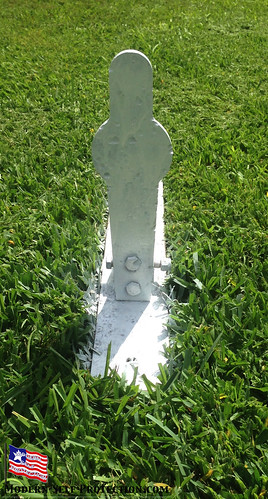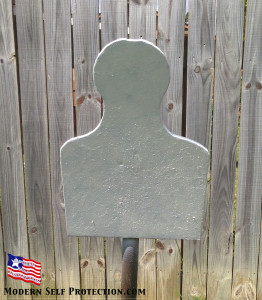I love shooting steel! It’s fun and can be used for great training. It gives immediate feedback and allows you to learn follow-up shots faster and improve your accuracy with less practice, and it keeps your ego in check. If you miss, everyone knows you missed. Here’s a break down of the types of steel targets and how you can use them to improve your shooting skills:
Types
Three basic types of steel targets are static, reactive, and gong. A static target is just a piece of steel that sits there and you shoot it. It could be in different shapes, angles, and heights. This is my favorite type and I think the safest, if used and set up properly. Reactive is a lot of fun and can improve your accuracy and speed, but they aren’t as safe for yourself and others around you. Reactive is any kind of steel that does something when you hit it, including fall over, swing, or pop back up. Last are gongs. They are great fun and can push your accuracy up faster than just about anything else. Normally, this is a steel plate hanging from a chain (kind of like the musical instrument), really easy to set up and use. Normally, the steel will last the longest.

Basic safety:
Safety is an issue with steel targets. You are firing a little piece of lead at over the speed of sound and hitting something hard. Bullets do funny things when they hit something hard. For simplicity, we are just going to talk about using handguns. Rifles and shotguns are in an entirely different league.
Shoot good quality steel in good shape is the best way to go. How do you know it’s good quality? When you shoot it, the steel doesn’t pit or deform for a long time. When steel starts to get worn out it starts to chip edges off and create pits or craters on the steel. When this starts happening it’s a good time to retire that steel or make it a long-distance plate only. When a bullet hits one of those sharp edges, it does unpredictable things. Steel with pits, holes, or pieces missing, I would be on the safe side and make it 25 yard or more steel.
Use eye protection always. Use the wrap around kind, not just reading glasses. Make sure everyone on or around the range is wearing eyeglasses. When I’m teaching a class, if we are shooting paper, as soon as you step off the line, you can take your glasses off. If we are shooting steel, everyone is always wearing eye protection and if possible facing towards the targets to make sure any little pieces flying around don’t go through the side of the glasses.
Ammo:
FMJ (Full Metal Jacket), HP (Hollow Points) and frangible ammo all work differently. HPs are the most dangerous to shoot steel with. They are designed to hold together to make the biggest wound channel inside a bad guy. They will do the same thing on steel. The bigger the pieces flying around, the more chance there is to hurt someone. That’s where frangible ammo comes in. I’ve tested a limited amount of frangible ammo and don’t find any significant safety margin for the frangible stuff, at least not enough to warrant the extra price. With frangible, I can get about 1 yard closer than with FMJ. I like using FMJs because they are the cheapest and seem to go towards the ground the most.

There are some boxes marked FMJ that have flat noses in them. I’ve found that those don’t work as well because the edge seems to catch and make the bullet do different things. With the true FMJ, the bullet is deflected with the round nose even if it doesn’t break apart.

Using Static Steel
It’s my favorite type to train with and lets you shoot faster and faster without worrying about anything else. The steel needs to lean forward a great deal. I like 15 to 30 degrees. If it looks like it’s going to fall over, it’s probably about right. The lean makes the bullet deflect down and away from the shooter.
Now we have a target that we can get pretty close to (I’ve done it at three yards, but five is more reasonable), or any longer distance you want.
I also love using static steel to learn how to shoot on the move. It gives you immediate feedback and lets you know when you are doing it right, so you can shoot entire magazines without having to check your targets. If you are trying to train yourself, feedback is going to be the most important thing to you.

Using Gongs
I’ve used them in the past and can help you best on your long-range shooting and hand eye coordination to shoot moving targets. Depending on how the gong is hanging, it starts moving after you hit it once. I used a gong overseas that was hung on a 5 foot chain, so hitting it with a handgun would start it swaying and spinning. It’s a nice challenge but it’s hard to work on anything else.

Reactive Steel
Reactive steel is great for scenarios. We always talk about shoot the target until it is no longer a threat and/or is down, both are hard to do with a paper target. Reactive steel lets you shoot until the target goes down and then move onto or do something else. It’s really nice to work multiple targets, it helps you learn to make hits before you move on, and the biggest thing is that there is no cheating. You are either making the steel move by hitting it or you are not.
Reactive Steel comes in a variety of different configurations from plates that just stand up and fall over when you hit them, to pepper poppers on a base and pivot (some with springs so they stand back up on their own, my favorite), to fancy ones that once you hit it, the target does something else (like a spinning plate target).
Have Fun
Using steel is the most fun way to train or plink. Given the choice, I will shoot steel over paper or anything else. The only down side, you have to carry it and it’s heavy. I use targets from MGM and Salute right now but am looking at a couple other companies to get more steel.
Stay Safe,
Ben
P.S. Don’t be this guy!

Did you know that the video you posted here was made by George “Mad Ogre” Hill?
He told me in a class that they angled the steel correctly, but the bullet made a divot in the steel, and then bounced back out from the divot. They think the round was under charged, because a normal .50 BMG round would have zipped right through the plate that they were using.
I didn’t know that. What a weird set happenstance to make that happen. I didn’t think about that. At that short of a distance it would have to be a massive piece of steel for it not to go through. I am glad that no one was hurt but that would scare the crap out of me.
Thanks for the info DS and thanks for reading my blog. How’d you find it?